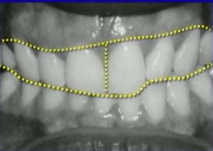Steps in the Veneer Seating Process, Part I
When dentists discuss the procedures they are fearful of, placing porcelain veneers frequently comes up as one of the most anxiety-producing. In this article, I’d like to highlight my seating process technique.

I have been doing veneers for over 25 years. Back in 1986, when I first started doing veneers, I used to bond all the veneers at the same time, but my technique has evolved over time.
The patient I’m going to use as an example is pictured. Before the seating appointment, she had undergone two years of orthodontics to intrude the right canine, lateral, and central, which had significant wear and were over-erupted. I then prepped all six anterior teeth for veneers.
- Remove the temporary. If you spot the bond in the temporary place, as I do, you will probably have to grind through the bonded area to allow for removal.
- Verify if the area is clean. After removing the temporaries, it’s imperative to ensure all the cement has been removed and the dentin is clean. If there is any resin cement on the prep in the bonding area, it can easily be removed using a high-speed brownie or a KS0 bur. I follow this with air abrasion of the entire prep using aluminum oxide.
- Place veneers, check contacts. Once the area is clean, you can place the veneers on the preps and check the contacts and margins. At this stage, I try the veneers in dry. Once I know the veneers fit acceptably, I use water as a “try-in” paste to evaluate color. If the water try-in looks good, I’ll use translucent cement to seat the restorations. If the color is problematic, I’ll try some colored try-in pastes to determine which cement I might use. In particular, the WO cement from the 3M veneer cement kit can be a lifesaver to brighten the restorations without making them appear too opaque.
In Part II, I’ll discuss Steps 4 through 8 of properly seating veneers, beginning with materials.
SPEAR campus
Hands-On Learning in Spear Workshops
With enhanced safety and sterilization measures in place, the Spear Campus is now reopened for hands-on clinical CE workshops. As you consider a trip to Scottsdale, please visit our campus page for more details, including information on instructors, CE curricula and dates that will work for your schedule.

By: Frank Spear
Date: October 12, 2017
Featured Digest articles
Insights and advice from Spear Faculty and industry experts


